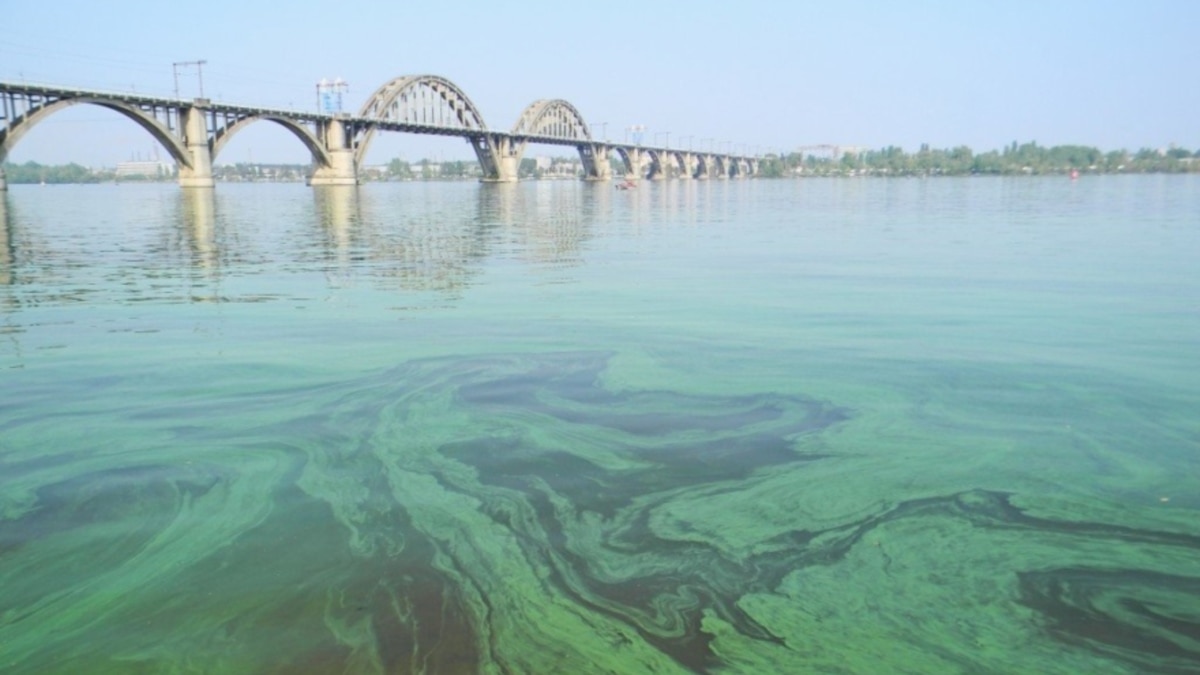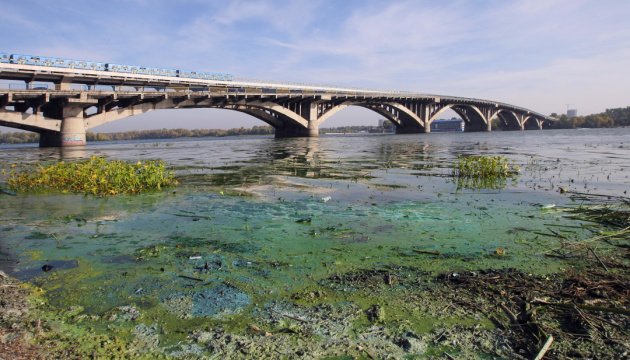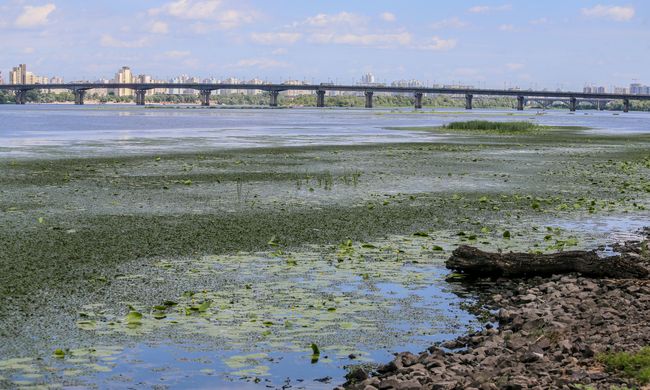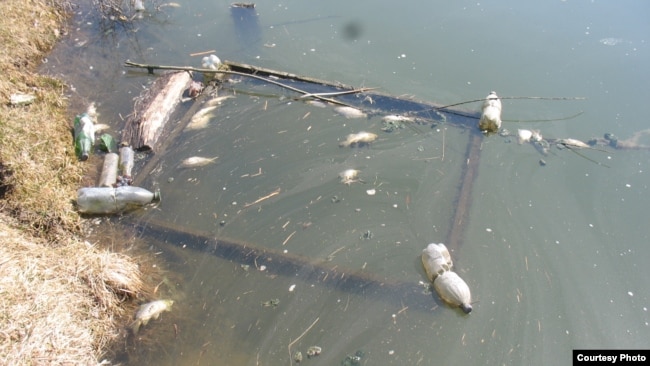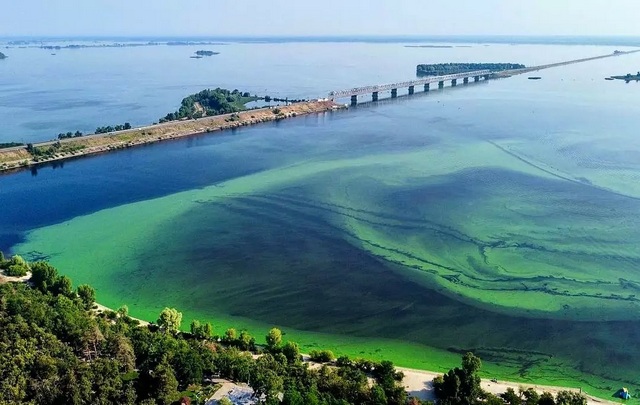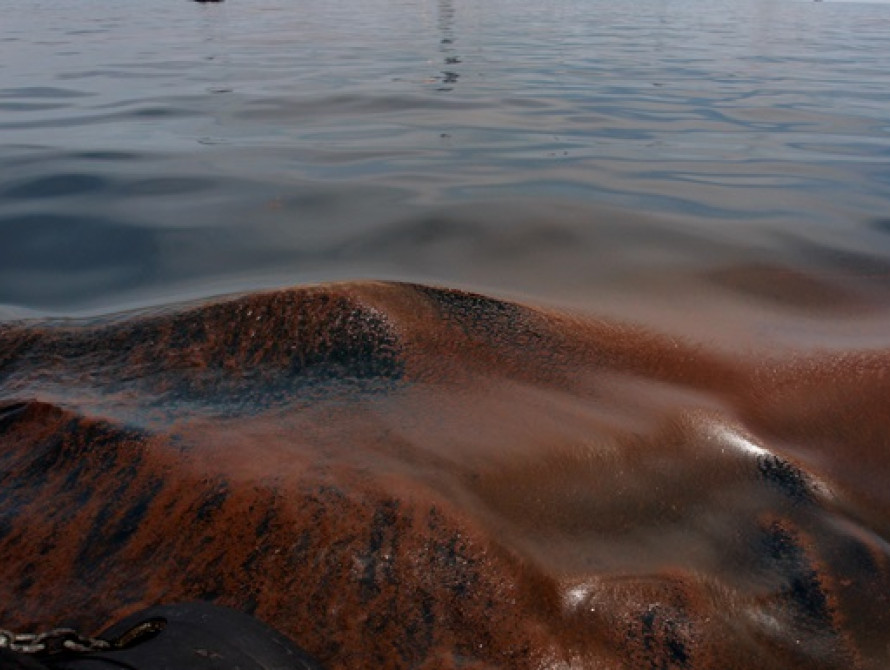Problems
The ecological condition of the Dnipro River is catastrophic
161 pollutants were detected in the surface waters of the Dnipro River basin, in particular, the herbicide atrazine and the metals cadmium and nickel. This threatens the health of the population of Ukraine and may cause an ecological disaster. This is evidenced by the results of the audit of the effectiveness of implementing measures of the State-wide target program for the development of water management and ecological improvement of the Dnipro River basin until 2021. Water quality indicators in the river are deteriorating. Recent studies have revealed significant excesses in the content of synthetic substances: agricultural poisons, pharmaceuticals, substances used in perfumery, synthetic musk, heavy metals zinc and copper, as well as mercury. In addition, the flowering of the Dnipro is one of the main causes of the mass plague of fish. The situation is also worsened by the shallowing of the river, which occurs due to the lack of dredging, which was carried out when the river was used as a transport artery. Thus, the ecological state of the Dnipro basin is catastrophic. If the ecological situation in the river basin does not improve, the water will continue to be polluted. It will be necessary to clean it completely.
Gallery
6Timelines
2024
April 08
After the eco-inspectors reported that they managed to eliminate the leaks, bloggers, and fishermen later began to publish videos and photos of the dead fish. So, a dead fish was found near the Vyrva tract. On April 8, eco-inspectors took water samples at the place of the fact of fish death. Deviations from the norm were recorded in water samples. “Water with a pH of 9.17 is considered alkaline, which may indicate an increased concentration of basic substances in the water, such as hydroxides. This may be caused by emissions caused by enemy strikes on the Dnipro HPP," the State Inspectorate of the Southern District reported. Despite the publications of the State Inspectorate and bloggers, the head of ZOVA announced that "the plague of fish has not been recorded." He also reported the following: Approximately half a ton of petroleum products leaked into the Dnipro due to a rocket hitting the engine room building. The State Ecoinspection recorded soil contamination and petroleum product stains. To eliminate this blockage, 480 liters of sorbent were spread in places of local formation of foam and oil stains on an area of 5,000 square meters. Deviation of water quality from the standards was registered according to the indicators "color", "hydrogen pH indicator" and "chemical oxygen consumption". The preliminary estimated amount of damage to water resources is 159.3 thousand hryvnias.
March 28
The State Inspectorate reported that they had taken measures to eliminate the oil leak in the Dnipro. Eco-inspectors reported that it was possible to eliminate the leaks.
March 22
The occupiers fired eight rockets at the largest hydroelectric power station in Ukraine - Dniprovskaya in Zaporizhzhia. As a result of missile strikes, oil leaked into the Dnipro River.
2023
May
The Economic Court of the Cherkasy region has completed consideration of the case on the claim of the State Ecological Inspectorate of the Central District with the participation of prosecutors of the specialized environmental prosecutor's office against the communal enterprise "CHELUASH" of the Cherkasy City Council for the recovery of almost half a million hryvnias of damage caused to the state due to pollution of the Dnieper River with sewage, and implementation without permission for special water use. The inspectors of the Central District State Ecological Inspectorate, through a 10-day monitoring of the quality of discharged wastewater due to the release of rain sewer at berth No. 5 in Cherkasy, exceeded the indicators of individual chemicals. In addition, the utility company did not have a permit for special water use and an approved list of maximum allowable discharges at the time of the audit. Considering the arguments of the environmental inspectorate and the prosecutor, the court fully satisfied the claim.
2021
December 24
"According to the latest audit of the Accounting Chamber of Ukraine, more than 161 chemical elements are polluting the Dnieper River. These are synthetic compounds and metals, pharmaceuticals, pesticides, agrochemicals, and quite a large list of chemical elements," said Pavel Ivanov, head of the Metropolitan District SEI. According to the head of GEI of the Capital District, 90% of sewage treatment plants at factories are worn out and need modernization because they can not filter out harmful impurities that fall into water resources. Adopting the "Drinking Water of Ukraine 2022-2026" program can help.
2020
August 12
There is a complicated hydrological situation in the Dnieper basin. All tributaries of the river have abnormally low water content, and water inflow to the reservoirs of the Dnieper cascade "is one of the lowest during the period of instrumental observations. "The maximum daily water inflow to the Kyiv reservoir was formed on March 30-31 at 950 m3 / s (the norm 4200 m3 / s) - one of the lowest maximums over the past 100 years. Only the daily inflow to the reservoir in the extremely low-water year 1925 was less - 892 m3 / s," - say, hydrologists.
2019
July 02
According to the head of the State Environmental Inspectorate Andrei Malyovany, in 2019 only within Kyiv, 723.2 million cubic meters of wastewater were discharged into the Dnieper. 40% of them were untreated. The Ministry of Environmental Protection and Natural Resources of Ukraine has compiled a rating of the largest enterprises-polluters for 2019. According to the results of the analysis, according to the discharges of polluted wastewater, the first is "Kievvodokanal". Compared with 2018, the number of discharges from the enterprise increased by 4 million cubic meters and totaled 287.4 million cubic meters.
2018
March 15
In March 2018, two bills on limiting the use of phosphates in agriculture were registered in Parliament. It is known that they play a massive role in the causes of water blooms in the Dnieper River. However, the main scientific and expert department of the Verkhovna Rada returned both bills for revision.
2017
July 07
Samples showed that some elements in the Dnieper exceeded several times: manganese - 3-7 times, copper - 13-23 times, phenols - 4-6 times, iron - 4 times, zinc - 1,5 times. Scientists insist on immediately adopting appropriate measures, otherwise, future generations of Ukrainians will feel the destructive consequences of the polluted Dnieper.
2016
June 09
Scientists noted that the Dnieper River turned into a solid swamp. Blue-green algae actively breed in shallow water. They rot, absorbing oxygen from the water. Experts have estimated that since 1932 the Dnieper Dam was built, the number of blue-green algae has increased a million times. According to studies, if the dams are not lowered, the Dnieper will disappear in 300 years.
2015
August 08
"We see that the water in the river is scarce and blooming. We cannot blame only one man for this. Recent years have been very low-water years. According to observations, there has never been such an amount of water in the Dnieper. In 2015, the water level in the river was the lowest in the post-war years", - reports Victor Vishnevsky, professor, Ph.D.
